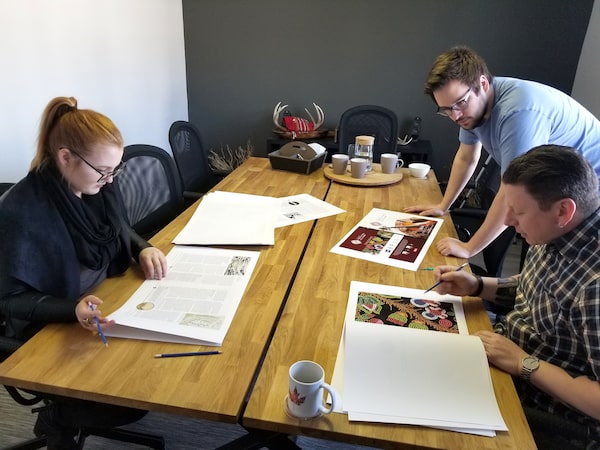
Vincent Design putting together the Indigenous Peoples Atlas of Canada.Vincent Design
Canadian Geographic is about to release an Indigenous Peoples Atlas of Canada, and Shaun Vincent’s fingerprint is all over it. Vincent is the founder and namesake owner of Vincent Design, a six-person Winnipeg firm that submitted the winning bid to design the ambitious four-volume educational resource. The circular logo for the encyclopedias is eye-catching and meticulously conceived – the compass-shaped symbol represents guidance while also evoking the traditional medicine wheel. According to the man who put it together, however, there’s more to it than that.
“It’s our fingerprint,” says Vincent, a designer with Métis roots. “It represents every Indigenous nation across Canada. People told me you can’t have a logo that’s busy, but I think this one works.”

A fiddle that once belonged to Métis fiddler Andy Dejarlis graces the cover of the Métis volume.Vincent Design
Vincent (with accounts manager Chris Redekop and graphic designer Kali MacDonald) spent an indefatigable year and a half designing the books, which are destined for schools and libraries across the country. The logo alone was a significant challenge. “With so many symbols, so many people and so many meanings, it wasn’t easy to represent it all,” says Vincent, a graduate of Red River Community College’s graphic design program in Winnipeg. “And we also wanted the logo itself to tell the stories of the books.”
Three books are each dedicated to a Canadian Indigenous group: Inuit, Métis and First Nations. A fourth volume (Truth and Reconciliation) is comprised mostly of maps, with a foreword devoted to the history of residential schools, redress and healing, courts and litigation and the road to understanding.
Each book cover sports a culturally relevant image – a fiddle from Le Musée de Saint‐Boniface that once belonged to the late, great Métis fiddler Andy Dejarlis graces the Métis volume – against a relief-map backdrop that echoes and reinforces the fingerprint concept of the logo.
The project is a culturally significant one. According to Vincent, all the content and design was supplied and put together by Indigenous people. “This has never been done together quite like this. People are telling their own history.”
Know of an unsung arts and culture hero who deserves wider acclaim? Send suggestions to bwheeler@globeandmail.com
 Brad Wheeler
Brad Wheeler